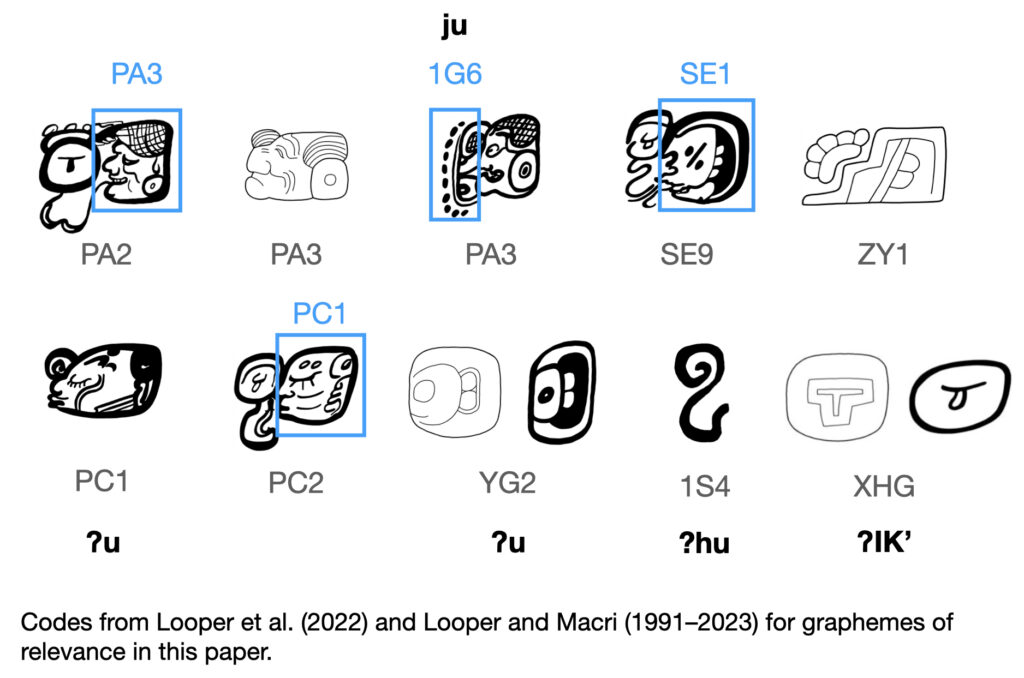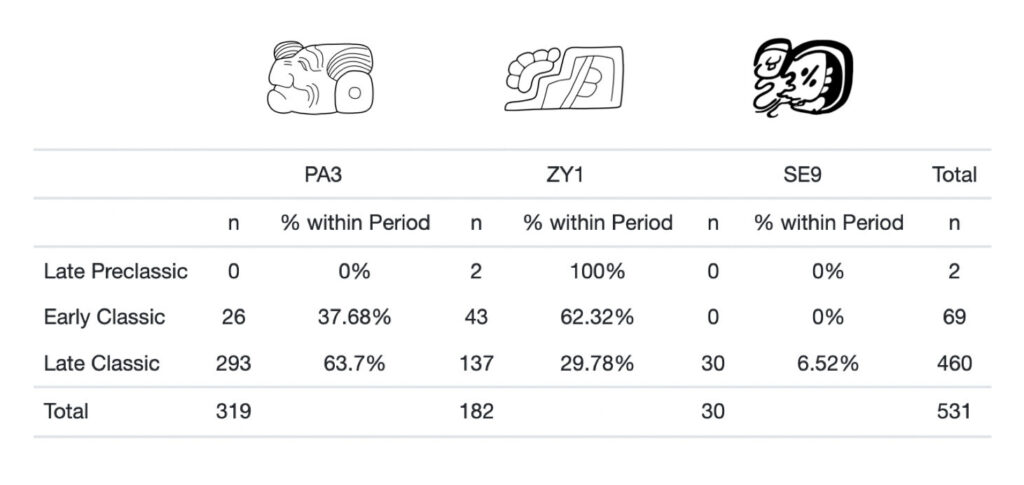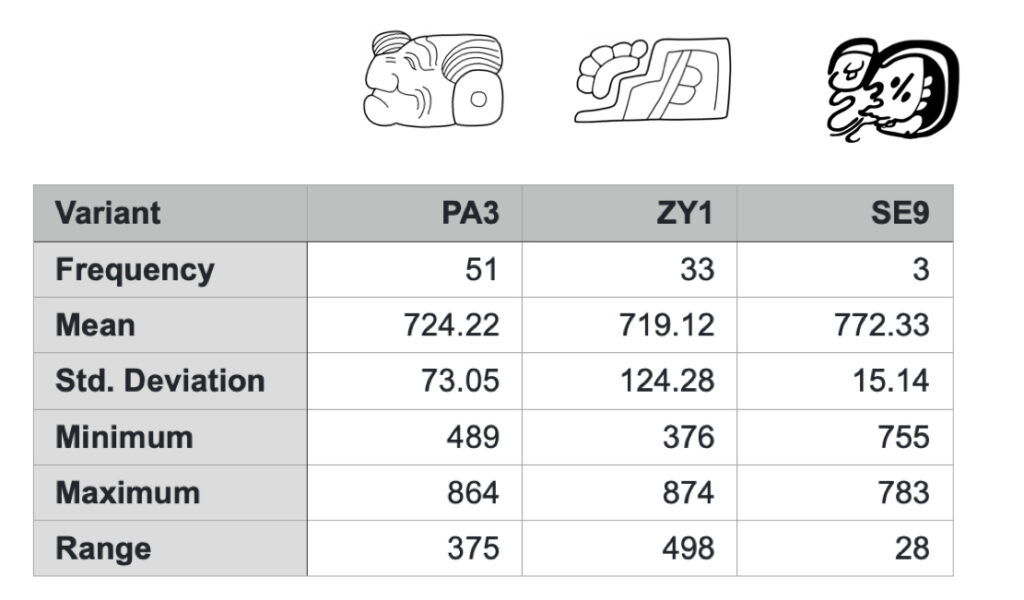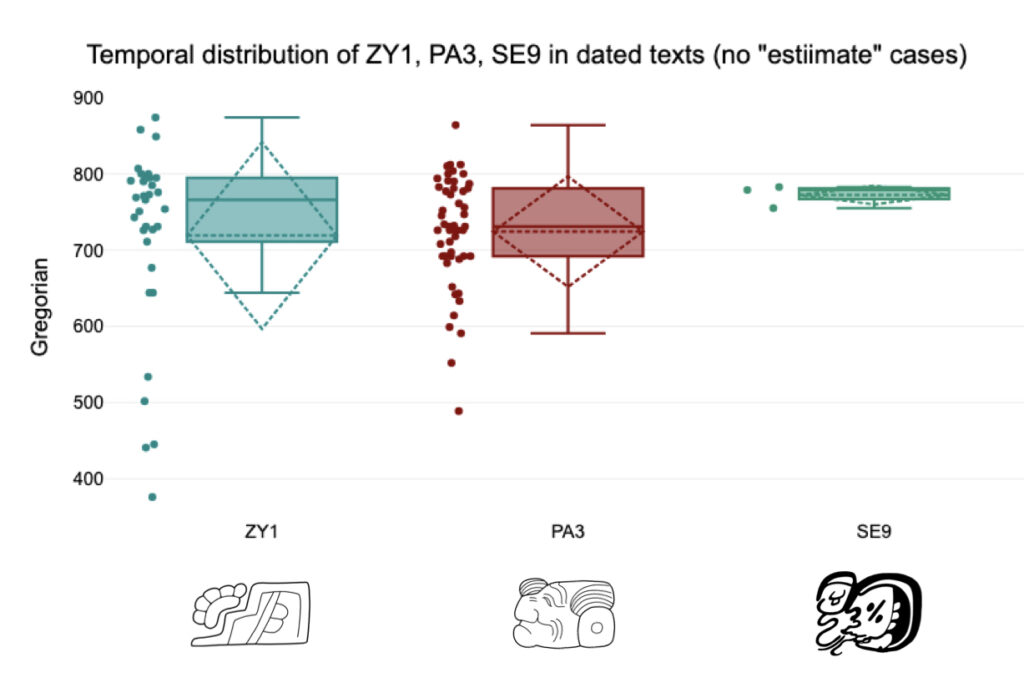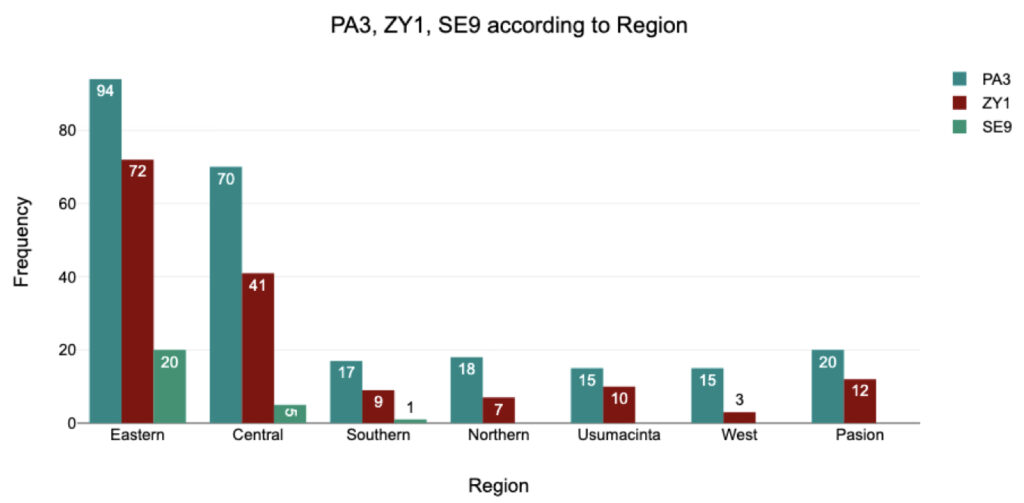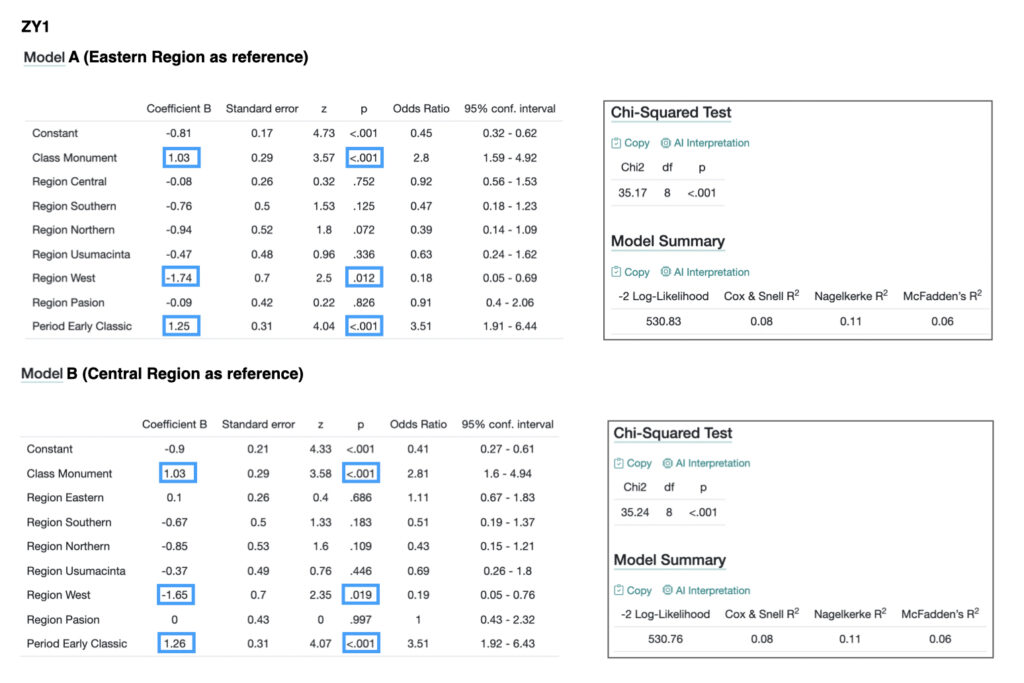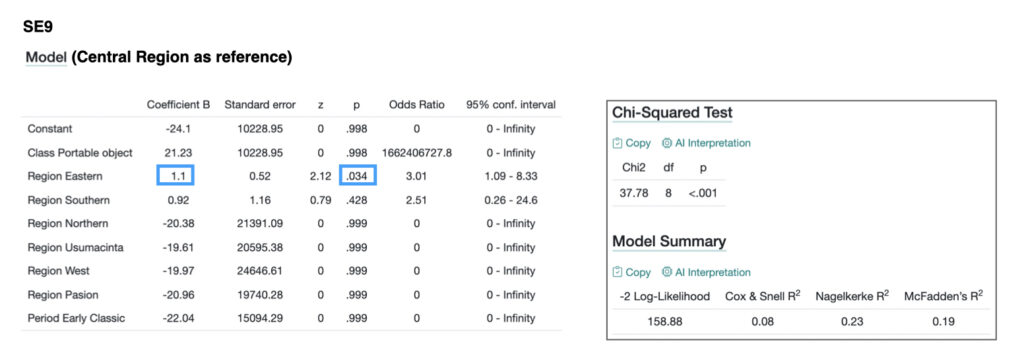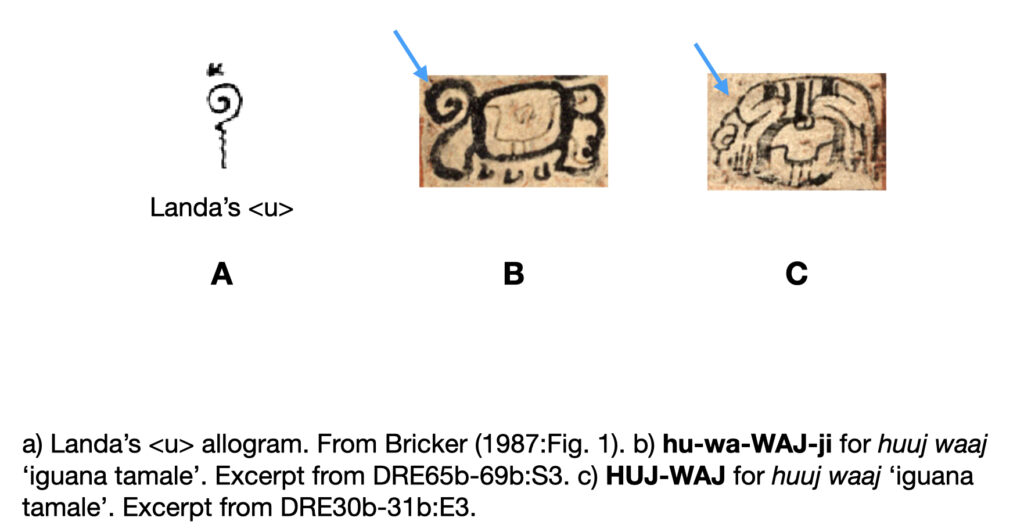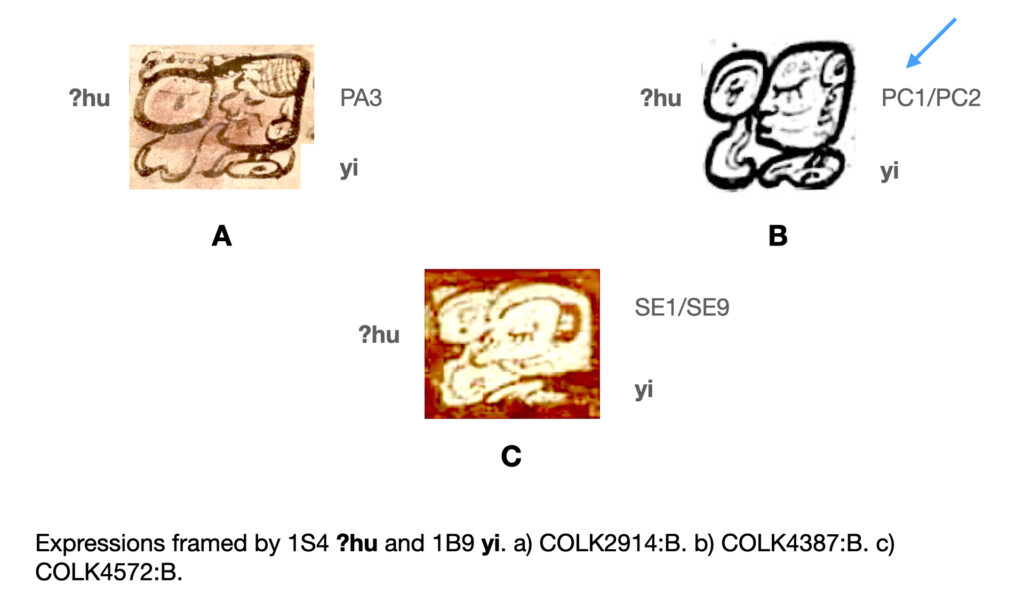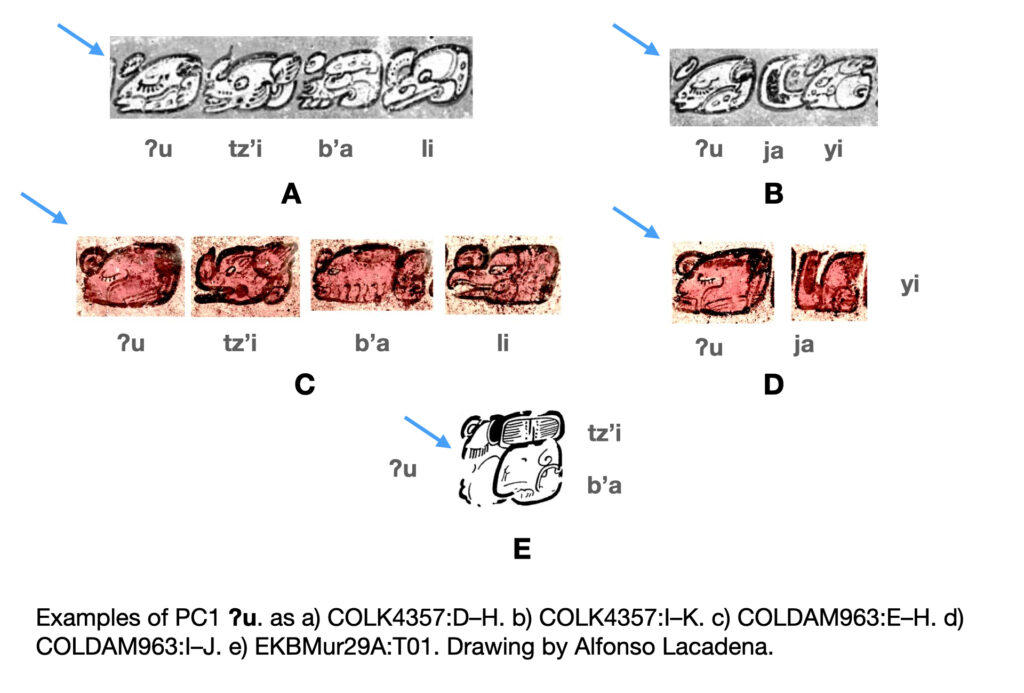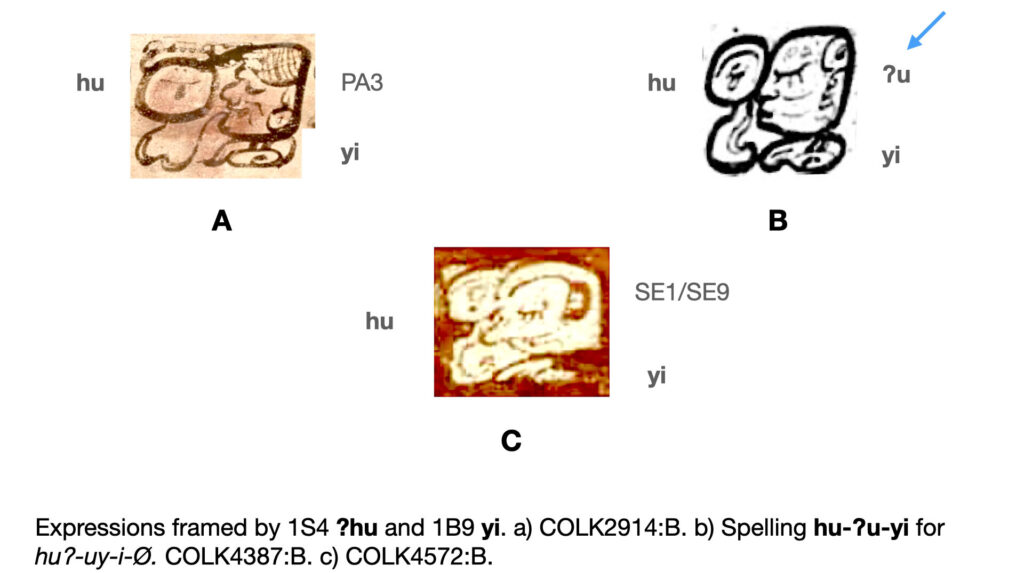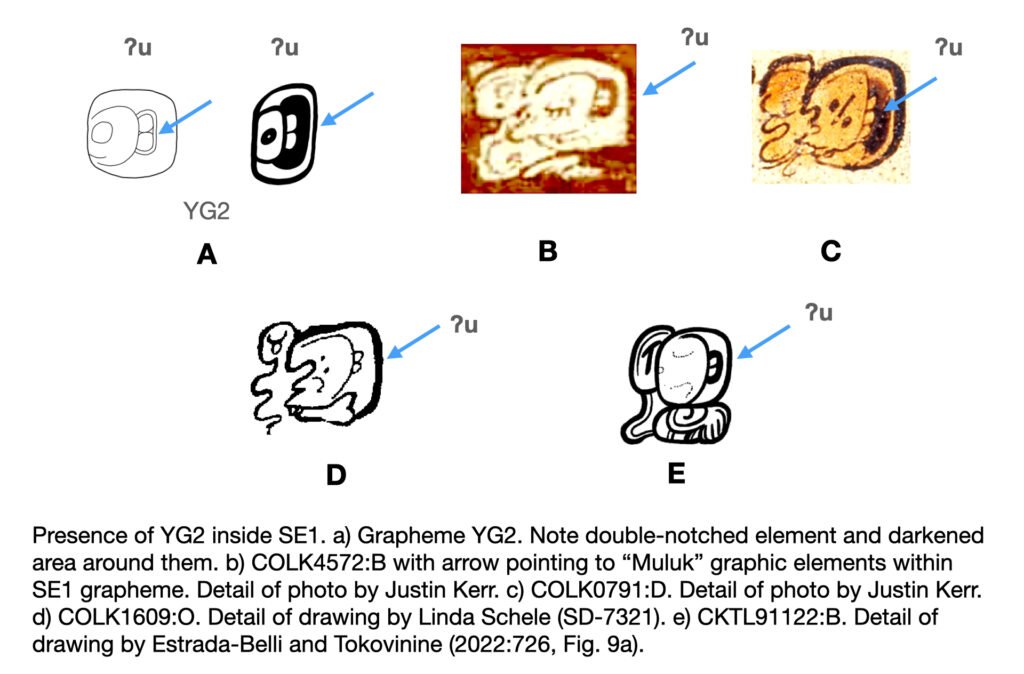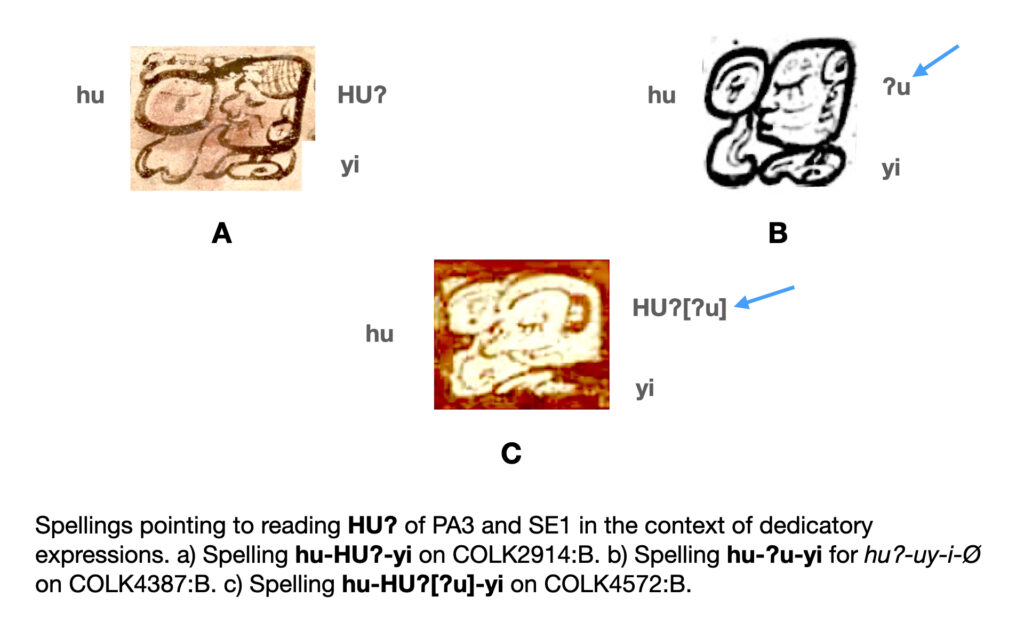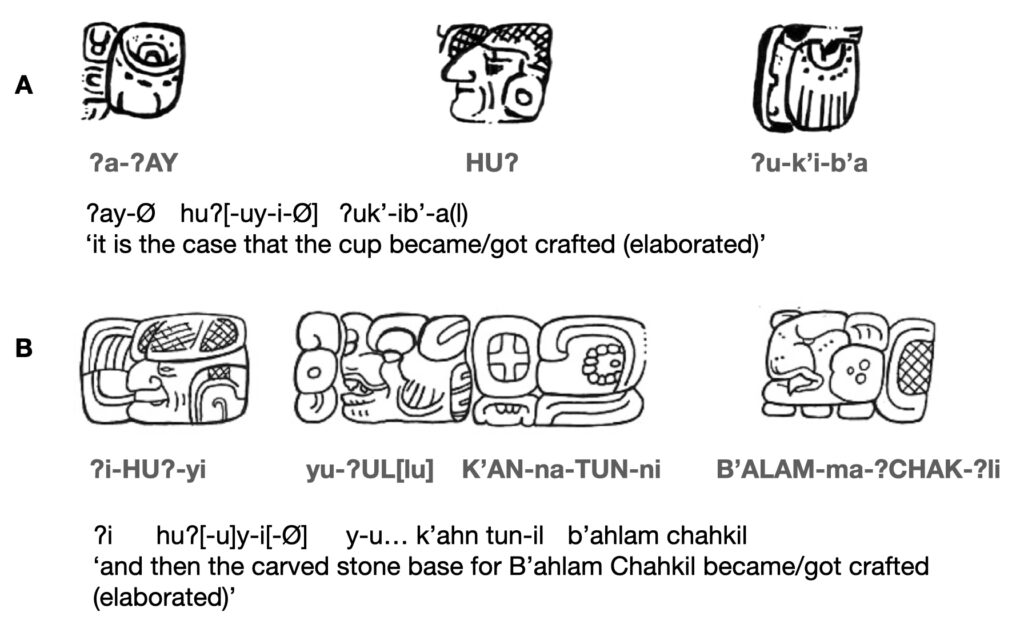Additional Remarks on the Value of the Verbal GOD.N Glyph as a HUʔ ‘to be able to; to finish (crafting/building)’
David F. Mora-Marín
davidmm@unc.edu
University of North Carolina
Chapel Hill
1/7/2024, typos corrected and Figure 1 revised on 1/8/2024
The verbal GOD.N glyph has remained problematic. Previous proposals for the reading of the verbal GOD.N glyph, prevalent in the Primary Standard Sequence (PSS) texts on portable objects, but also common on monumental texts, include primarily the following: HOY/HUY ‘to debut, to inaugurate’ (MacLeod 1990); T’AB’ ‘to anoint’ (Elisabeth Wagner, cited in Schele and Grube 1995 and Schele and Looper 1996); T’AB’ ‘to rise’ (Stuart 1995, 1998, 2005); a reading based on Ch’orti’ uhui ‘to sigh, snort’ or the Tzeltal entries hu’xiyel ‘blow, also a curing ceremony’ or hu’ ‘be able, can, take place’ (Schele and Grube 1997:81–82); among others. In Mora-Marín (2007a) I found evidence supporting the line of reasoning by Schele and Grube (1997), and proposed a reading as HUʔ (or ʔUʔ), arguing that it was based either on a root for ‘soplar (to blow air)’ or ‘poder (be able to)’. This note points to the evidence for the reading HUʔ based on a Tzeltalan root *huʔ ‘poder (to be able to)’, reconstructed to proto-Tzeltalan as *huʔ ‘hacerse, terminarse (to be made, to be finished)’ by Kaufman (1972:103). I suggest that this root was likely present in Greater Tzeltalan, the direct ancestor of both the Ch’olan and Tzeltalan languages, and that it was used in the Classic Mayan texts to refer to the crafting or building, and possibly to the “enabling” (imbuing with power) of objects and structures, but that it was subsequently lost from Ch’olan languages.
Here, then, I will carry out five tasks: 1) provide an overview of the graphemes involved; 2) briefly discuss the distribution of PA2/PA3 and its possible substitutional (graphemic or lexical) variants with respect to time, region, and media type; 3) review the spelling patterns that support a reading HUʔ for the PA2/PA3 logogram (and possibly its variants); 4) narrow down the lexical value of said logogram in the context of dedicatory texts to *huʔ ‘to be able to; to be made; to be finished’; and 5) present additional evidence from PSS contexts supporting this assessment.
First, it is necessary to introduce the graphemes of direct and indirect relevance (cf. Looper et al. 2022; Looper and Macri 1991–2024), as seen in Figure 1. I believe that the BREATH element graphically prefixed to PA2, and bearing an infixed T503/XHG ʔIK’ ‘wind’ grapheme, is simply a more elaborate version of 1S4. Also, as I show below, this BREATH element is likely its own grapheme, possibly polyvalent/polyfunctional in nature, and should be treated separately. For this reason, in my dataset, I have collapsed PA2 and PA3 as one grapheme (PA3). The same can be said of SE9: it is composed of 1S4 and SE1, at least graphically. While SE1, which in most Classic-period contexts constitutes the DEATH expression, and thus logographic CHAM/KAM/KIM, for a reflex (or multiple reflexes) of proto-Mayan *kam ‘to die’, such as proto-Ch’olan *chäm ‘to die’, in the dedicatory context of the PSS, and perhaps also in the Postclassic augural context, it may have a different value and function, as suggested below. (If it is indeed ‘death’ in the PSS contexts too, a question to ask would be whether pottery vessels bearing SE9 are typically treated in a different manner as others, perhaps with a drill hole on the base for ritual termination.) And again, the same is likely the case with PC2, which I take to be simply a case of 1S4 prefixed to PC1 ʔu, for which evidence is also presented below.
Figure 1. Codes from Looper et al. (2022) and Looper and Macri (1991–2023) for graphemes of relevance in this note.
A few words about PA3 and its common substitutes are in order. These include ZY1, SE9/SE1, and PC2/PC1. Whether such substitutes are merely graphemic (allograms representing the same lexeme), lexical (different graphemes representing different lexemes), or other (only equivalent from the point of view of visual composition of glyphic expression, but not otherwise equivalent graphemically/orthographically), is another matter. There is another sign that qualifies as a substitute, given the definition just provided, namely PJ8. However, as I have argued recently (Mora-Marín 2023a), PJ8 is likely an amalgamation of two different expressions, one of which is in fact a separate verbal expression in the PSS. Regarding the question of the substitution involved, there are at least two texts in which PA3 and ZY1 co-occur, as noted by previous authors (MacLeod 1990; Mora-Marín 2001, 2007): in one of them (K), they appear in succession, suggesting they are not graphemic substitutes, but lexical substitutes, possibly synonyms or otherwise contextually associated verbal expressions. Nevertheless, PA3 and SE9 do not co-occur, and could potentially represent graphemic substitutes representing the same lexeme, at least in the context of PSS texts at least, or perhaps represent distinct verbal expressions in complementary distribution.
Next is the second task, which pertains to the distribution of PA3 and associated graphemes I am utilizing, as usual, the Maya Hieroglyphic Database (MHD) by Looper and Macri (1991–2024), as well as DATAtab (DATAtab Team 2024) to carry out descriptive and inferential statistical tests, as well as to prepare charts of different types. Focusing on the Classic period, I prepared a dataset including the PA3, ZY1, and SE9 graphemes consisting of 531 examples. Table 1 presents their distribution according to Time Period. Cases of SE9 (SE1) are entirely restricted to the Late Classic period. Note that the majority of examples of PA3 are found in the Late Classic, while the majority of cases of ZY1 are found in the Early Classic.
Table 1. Distribution of PA3, ZY1, and SE9 according to Time Periods.
Table 2 presents the basic distributional statistics of each grapheme in dated texts (n = 87), excluding texts with “estimate” dates in the MHD. Figure 2 plots the distribution of the dated examples in the form of Box Plots for each grapheme. Note that the dated examples make up only a relatively small proportion (16.4%) of the total of 531 cases.
Table 2. Distribution of PA3, ZY1, and SE9 in dated texts.
Figure 2. Box Plot of distribution of ZY1, PA3, and SE9 in dated texts (n = 87).
Next, Figure 3 provides a Bar chart of the total dataset showing the distribution of the three graphemes according to Text Class, whether portable or monumental. It should be noted that SE9 (i.e. 1S4.SE1) does not occur on monumental texts at all. It would appear that PA3 shows up more frequently on portable texts, relative to ZY1.
Figure 3. Bar chart showing distribution of three graphemes according to Text Class (portable vs. monumental).
Next, Figure 4 illustrates the regional distribution of the three graphemes. The most obvious pattern appears to be that SE9 seems to be restricted primarily to the Eastern region (e.g. eastern Peten, Belize), and secondarily to the Central region. However, it should be noted that these regions make up the majority of the records in the dataset (56.9%). Perhaps SE9 was just rare overall: within the Eastern region, SE9 cases make up 10.8% of the total for that region, while in the Central region, SE9 cases make up 4.31% of the total for that region. Perhaps in the remaining regions, with significantly fewer representation overall in the dataset, cases of SE9 existed but were too rare to be preserved.
Figure 4. Bar chart depicting regional distribution of the three graphemes in question.
In any case, I decided to apply a Logistic Regression analysis to the dataset to look for significant patterns. Table 3 presents the results for the analysis of grapheme PA3. Suffice it to say, that, when the Eastern region is used as a reference category for the Region variable (Model A), the Northern region appears to show a significant, positive correlation with PA3, as does the West region (e.g. Pomona-Tabasco, Tonina, Palenque), but when the Central region is used as a reference category (Model B), only the West region shows a statistically significant, positive correlation with PA3. Also, it should be noted that PA3 is significantly and positively correlated with portable objects, as far as Object Class, and with the Late Classic period, as far as Time Period. Thus, scribes were more likely to use the PA3 on portable texts, and generally used it increasingly over time at the expense of ZY1.
Table 3. Part 1 of results of Logistic Regression (LR) analysis. Dependent variable: Grapheme “Variant” (whether PA3, ZY1, or SE9). Independent variables: Region, Time Period, Object Class. Part 1 includes LR Model for PA3 only.
Table 4 presents the results for the analysis of grapheme ZY1. Whether the Eastern region or the Central region is used as a reference category for the Region variable, the results are similar: ZY1 shows a significant, negative correlation with the West region, and it shows significant, positive correlations with monumental texts and the Early Classic period.
Table 4. Part 2 of results of Logistic Regression (LR) analysis. Dependent variable: Grapheme “Variant” (whether PA3, ZY1, or SE9). Independent variables: Region, Time Period, Object Class. Part 2 includes LR Model for ZY1 only.
Grapheme SE9 is not frequent enough to obtain more reliable results. The only noteworthy result is a significant, positive correlation with the Eastern region. (Even the fact that all 30 cases are restricted to the Late Classic period does not seem to be significant.)
Table 5. Part 3 of results of Logistic Regression (LR) analysis. Dependent variable: Grapheme “Variant” (whether PA3, ZY1, or SE9). Independent variables: Region, Time Period, Object Class. Part 3 includes LR Model for SE9 only.
It is now time to delve into the third task: the spelling patterns for PA3, primarily, compared to those of SE9 and PC2. I will study the spelling patterns for ZY1 at a later time. First, what is 1S4 BREATH, seen in Figure 5A, doing in the spellings associated with PA3, PC1, and SE1, cataloged in Looper et al. (2022) and Looper and Macri (1991–2024) as graphemes composed of two graphemic components each? Figure 5B provides an example of 1S4 that seems to function as part of a graphemic unit with respect to the anthropomorphic head. Combined, the two seem to bear the logographic (lexographic) value K’AYOM for k’ay-om ‘singer’, a bimorphemic, derived noun, spelled out syllabographically as k’a-yo-ma in Figure 5C. Note that 1S4 as cataloged consists merely of a CURL motif. However, in the example of the logogram K’AYOM in Figure 5D, it also bears an infixed T503/XHG ʔIK’ ‘wind’ grapheme, just like the examples associated with the PSS verbal expressions (Figures 5E-5G). The point here is that 1S4 BREATH is the same grapheme present in the K’AYOM logogram, perhaps functioning in such instances as a semantic/lexical determinative (Mora-Marín 2023a), whether infixed with T503/XHG ʔIK’ ‘wind’ or not, and therefore, that it is also 1S4 that that we are also seeing juxtaposed to PA3, PC1, and SE1. The question now is, what is it doing when juxtaposed to PA3, PC1, and SE1 in the context of PSS verbal expressions?
Figure 5. The function of 1S4 BREATH with respect to PA3 (PA2), PC1 (PC2), and SE1 (SE9).
Stuart (2005:151) suggested that 1S4 functions as an association with the notion of something rising, and thus, with his proposed value for PA3, proto-Ch’olan *t’äb’ ‘to rise’. As several authors have remarked (Schele and Grube 1997; Bricker 1987; Mora-Marín 2007), 1S4 appears in the Postclassic codices and in Landa’s “alphabet.” In the latter, it is glossed as <u> (Figure 6A). Bricker (1987) proposed that in the codices, 1S4 could be used to spell /hu/, and thus possibly to function as a syllabogram hu, in the context of the ‘iguana tamale’ expressions, as seen in Figure 6B, with a possible spelling hu-wa-WAJ-ji for huuj waaj ‘iguana tamale’. Figure 6C shows the more common spelling of this expression, using IGUANA as a logogram HUJ.
Figure 6. 1S4 in later texts.
As Figure 7 shows, when we plug in 1S4 hu in the expressions of interest, the spellings hu-PA3/PC1/SE1-yi are obtained, showing an apparent equivalence among PA3, PC1, and SE1. Nevertheless, this equivalence is not exact, as will be shown shortly.
Figure 7. 1S4 as hu in PSS verbal expressions with PA3, PC1, and SE1/SE9.
Next, as was done in Mora-Marín (2007), it is time to examine the PC2 collocation, which I propose to consist of 1S4 hu and PC1 ʔu. But first, we note some of the uses and traits of PC1 ʔu. Figures 8A-B illustrate the graphic design of PC1 ʔu that show a person’s head with closed eyelid and what appears to be a fleshless lower jaw bone. These examples illustrate the common expressions ʔu-tz’i-b’a-li for u-tz’ihb’-al ‘its writing (of/on the vessel)’ and ʔu-ja-yi for u-jay(-il) ‘his/her vessel’. PC1 ʔu could occur without the fleshless lower jaw bone, as in Figures 8C-E. (The example in Figure 8C in fact seems to be the exemplar for PC1.) Not illustrated here, but reserved instead for a later note, are examples where PC1 ʔu shows an open eye.
Figure 8. Examples of PC1 ʔu outside of the PC2 context.
Given what was just presented, it is now time to return to the example of PC2: the human head glyph used in this spelling (Figure 9B) is the same as PC1 ʔu. Consequently, plugging in the value of PC1 ʔu to the hu-PC1-yi template yields hu-ʔu-yi. Given the apparent equivalence already established for the spellings hu-PA3-yi (Figure 9A), hu-PC1-yi (Figure 9B), and hu-SE1-yi (Figure 9C), one could argue that PA3 and SE1 are also likely syllabograms with the value ʔu. But this is not likely the case. There is more to the spelling patterns yet to be discussed.
Figure 9. Expressions framed by 1S4 hu and 1B9 yi.
Next, as I noted in Mora-Marín (2007), it would appear that SE1 bears an important clue: it seems to contain within it, as a result of graphic conflation, the grapheme YG2 ʔu, illustrated in Figure 10A. YG2 bears a double-notched element oriented horizontally; in painted versions, the area around such element is typically colored in with dark paint (red/black). SE1, the DEATH glyph, often bears this double-notched element, as well as the larger circular element to the left of the double-notched element; in such cases, the EYE or % element of the DEATH sign essentially occupies the space where the DOT element of YG2 would be placed. Maybe, one could imagine, the YG2 elements are mere optional graphic components of the DEATH expression. Nevertheless, there is paleographic evidence that this was not originally the case. Using the MHD, it is possible to examine approximately 114 examples of SE1, the DEATH expression. Interestingly, the earliest example of SE1 fused with YG2 used in a death verbal expression is found on La Corona Panel 2, dated to 9.11.16.2.8 (CE 668), with examples starting to pick up the pace in frequency during the eight century. In other words, during the Early Classic period, SE1 lacks the graphic elements characteristic of YG2. Recalling now that SE9 (1S4.SE1) in PSS texts is completely absent from Early Classic texts, I propose that: 1) the conflation of SE1 and YG2 is a Late Classic innovation; 2) that it arose in the context of the PSS texts where YG2 was functioning as a syllabogram ʔu; 3) that SE1 is polyvalent, with a value CHAM/KAM/KIM in death contexts, and a different logographic value in the PSS context; and 4) that in the PSS context YG2 ʔu functions in part as a phonographic complement to the second logographic value of SE1, which, based on the presence of 1S4 hu and the conflated YG2 ʔu would likely be HUʔ. Thus, I propose, the almost exceptionless use of 1S4 hu and YG2 ʔu with SE1 in the PSS contexts is a means of disambiguating its value HUʔ (n = 30) from its more frequent value CHAM/KAM/KIM overall (n = 114). But interestingly, after the SE1:YG2 conflation was innovated as a disambiguation, scribes began to adopt it for the more common value of SE1, but optionally, whereas in the context of the PSS verbal expression, it is almost exceptionless.
Figure 10. Evidence for conflation of YG2 and SE1.
What this means, then, as proposed in Figure 11, is that PA3 (Figure 11A) and SE1 (Figure 11B) are logograms with a basic phonographic value HUʔ. The reason for proposing logographic values for PA3 and SE1, as opposed to a syllabographic value ʔu, is that PA3 and SE1 are not known to appear in contexts where a ʔu value would make sense, for example, to spell the u- ‘third person singular ergative/possessive’ proclitic, but are in fact known to behave like logograms, with PA3 often appearing as a lexogram, representing an entire verbal expression (with derivational and inflectional suffixes) on its own. Thus, the spellings in Figure 11 are orthographically equivalent, but PA3, PC1, and SE1 are not orthographically equivalent. Given this, the full expression represented by all three of these spellings should be read as the more phonographically explicit example hu-ʔu-yi suggests: huʔ-uy-i-Ø. So then, what does this word mean?
Figure 11. Proposed solution for PA3 and SE1 in the PSS verbal dedicatory expressions.
It is now time for the fourth task: narrowing down the lexical item of relevance to the value of PA3. Given the typical, dedicatory context of the PA3 verbal expression, and the fact that its subject can be inanimate entities of a wide variety of material culture (from stepped temples to bone needles), huʔ-uy-i-Ø likely expresses a general concept, such as finishing/completion or construction/crafting. I believe, as already indicated in Mora-Marín (2007a), that Schele and Grube (1997:81–82) were right on target when they suggested, among other possible lexical options, the Tzeltal and Tzotzil root huʔ ‘be able to’, an intransitive verb root that can function as a modal verb ‘can’. Table 6 presents the relevant citations for Tzeltal and Tzotzil cited in Mora-Marín (2007a:11). Slocum and Gerdel (1999:138) provide the following example: ay yu’el, analyzable as ay ‘exist’ and y-u’-el his-power-possessive.suffix, which they translate as ‘tiene poder, es poderoso (s/he/it has power, s/he/it is powerful)’. This suggests that this hu’-el is in fact a noun that refers to power contained in a person or thing. As already mentioned at the beginning of this note, the term has been reconstructed to proto-Tzeltalan as *huʔ ‘hacerse, terminarse (to be made, to be finished)’ by Kaufman (1972:103).
Table 6. Tzeltalan data for *huʔ ‘hacerse, terminarse’.
| Tzeltal (Slocum and Gerdel 1999:44, 138) | |
| hu’el ~ u’el [’u’el]
hu’el c’op [k’op] hu’tesel |
‘poder (be able to)’
‘lograr (to achieve)’ ‘terminar (to finish)’ |
| Tzotzil (Delgaty and Ruíz Sánchez 1978:71-72) | |
| ju’el [hu’el] | ‘poder, autoridad, dominio; poder (power, authority, domain; be able to)’ |
Polian (2018:258) has further documented this term in his multidialectal dictionary of Tzeltal, as seen in Figure 12, noting that the conservative form is /huʔ/, as in Bachajón, and the innovative form is [juʔ]. Observe the subentries (2)–(4) especially, with subentry (2) glossed as ‘terminarse de hacer, de construir, de elaborar (to finish making, building, elaborating)’ and the example referring to the construction of a house, and subentry (4) referring to the elaboration of a written document.
Figure 12. Entry for huʔ ‘poderse; terminarse de hacer, de construir, de elaborar; haber, suceder’ in Polian (2018:258).
The root huʔ with the right meaning does not seem to appear in the Ch’olan languages. A similar term is documented exclusively in Wisdom’s dictionary of Ch’orti’, as seen in Table 7. I present it because it is possible that such term may have experienced metathesis from an earlier shape /juʔ/, and that the /j/ may be traceable to proto-Ch’olan *h and proto-Greater Tzeltalan *h. However, this is a long shot. And the best bet remains the Tzeltalan term, which may have existed in proto-Greater Tzeltalan, and may have been inherited by Ch’olan speakers after their differentiation from Tzeltalan speakers, only to eventually become lost completely in all Ch’olan varieties.
Table 7. Ch’orti’ /ʔuj/ ‘good, sacred, moral’. Wisdom data based on Stross (1992).
| Ch’orti’ (Wisdom 1950:472, 746) | English Gloss |
| uh
uh ha’a uh-r-an uh-r-es |
‘good, sacred, moral’
‘sacred water (from church or sacred spring)’ ‘be moral or sacred’ [cl.3] ‘make moral or good, sacralize’ [cl.2a] |
An important issue to consider at this point pertains to the syllabogram ju. Looper et al. (2022) and Looper and Macri (1991–2024) considers 1G6 ju to function as an optional graphic component of PA3 rather than as a separate grapheme, as seen in the second version of PA3 in Figure 1 above. I believe this is not the case, and that ju became prefixed to PA3 during the Late Classic period as a phonographic complement. Either way, uses of 1G6 with PA3 begin in the Late Classic (8th century), with the earliest reliably dated case (FLDSt09) dating to 9.15.0.0.0 (CE 731), as the data in the MHD suggest. The use of ju in many spellings makes sense in light of the proposed hu- spellings: While proto-Ch’olan has been reconstructed by Kaufman and Norman (1984) as preserving the proto-Mayan *h : *j contrast in all positions, those same authors noted that all Ch’olan languages exhibit a merger of *h, *j > j, a change that may have occurred late in the process of proto-Ch’olan differentiation, or perhaps diffused between already differentiated Eastern Ch’olan and Western Ch’olan branches. Grube (2004) remarked on this phenomenon: in the ancient texts, roots with *h are sometimes spelled with jV syllabograms (e.g. ju-HUL-ya for hul-i-Ø > jul-i-Ø ‘it arrived’; ʔu-B’AH-ji for u-b’ah-il > u-b’aj-il ‘his/her portrait’). This is not anomalous, but the result of a the merger described by Kaufman and Norman (1984), a merger that was clearly in progress during the Classic period.
Finally, on to the fifth task: Is there additional evidence from the broader context of the PSS, supporting the lexical identification of PA3 as HUʔ ‘to be able to, to be made, to be finished’? Recall that PA3 covers a wide range of subjects, and must therefore represent a verb with a very general meaning that can apply to any kind of built or crafted object. Here I merely point to other verbal expressions utilized in connection with the dedicatory statements of object, whether monumental or portable. These include verbs such as proto-Ch’olan *pät ‘to construct, build’, a transitive root spelled PAT/pat or pa-ta in Classic texts, usually as a derived positional stem (with -laj or -wän suffixes); reflexes of proto-Ch’olan *ʔu[h]t ‘to finish; to come to pass’, a transitive root that was typically mediopassivized for the meaning ‘to happen, come to pass’, but was occasionally used to refer to the finishing of artifacts in PSS contexts (e.g. COLK8017, COLK9020, COLSDM10141, TNTAEG352, CHNSt02, XLMPan06). The verb *ʔu[h]t is reconstructed by Kaufman with Justeson (2003:739) as a “light” generic transitive verb, which they gloss as ‘to do it’ and ‘to say it’, documenting its distribution in Wastekan (‘to say to someone’), Tzeltalan and Tojol Ab’al (‘to say to someone; to scold someone’), and Popti’/Mocho’/Tuzanteko (‘to do it’, ‘to say it to someone’). Keller and Luciano (1997:274–275, 302) document various contexts with the meaning ‘to do/make’ in Yokot’an, as in mach a=ut-i-Ø patan sami,… ‘No se hizo hoy el trabajo (the work was not done today)…’, …ut-i-Ø tä México ‘… fue hecho en México (it was made in Mexico)’, and a=’ut-Ø-on ‘terminé mi trabajo (I finished my work)’. The Tzeltalan verb huʔ was not a transitive root, but is inflected as an intransitive or transitivized with a causativizer suffix. Its meanings ‘poderse; terminarse de hacer, de construir, de elaborar; haber, suceder (be able to; to finish being made, constructed, elaborated; to happen)’ are therefore similar to those of *ʔu[h]t, but scribes must have thought of them as complementary meanings, for in at least one case the two verbs occur in a dedicatory context in succession (COLSDM10141).
Figure 13 illustrates two sentences from different inscriptions with the proposed readings and translations. I have translated huʔ as ‘to elaborate/craft’ in these examples, but it could have easily been translated as ‘to make/complete’. I have assumed the inchoative function of the -V1y suffix typically employed by PA3 as defined in Mora-Marín (2007b, 2009). And as far as the Initial Sign Collocation, I use the value and function proposed in Mora-Marín (2023b, 2023c), as the existential particle with an evidential or perfective function in preverbal contexts.
Figure 13. Examples of phrases with PA3. a) Clause from COLK6697. Drawing by the author after drawing in Coe (1973). b) Clause from TNAMon146. Drawing by the author after drawing in Grube et al. (2002:56).
To conclude, the basic value of PA3 is likely HUʔ ‘to be able to, to be made, to be finished, to be elaborated’. In the typical PSS spellings, it spelled a word huʔ-uy-i-Ø ‘it became made/finished/elaborated’, or in Spanish, ‘se completó/finalizó/elaboró’. It is possible that the meaning ‘to be able (poder)’ may have been actually what scribes were intending: if so, huʔ-uy-i-Ø could be translated as ‘it became enabled’, or in Spanish, ‘se habilitó’. If so, the function of PA3 would have been to express that the object (its grammatical subject) was now ready for use.
What remains to be done: I do not think that the T843/ZY1 STEP sign bore the same value as PA3. While a value T’AB’ for the STEP sign seems plausible, and supported by recent research (e.g. Gronemeyer 2016), I suspect that there is more evidence that needs to be reviewed, a task for a future note.
References
Bricker, Victoria R. 1987 Landa’s Second Grapheme for u. Research Reports on Ancient Mayan Writing 9. Washington, D. C.: Center for Maya Research.
Coe, Michael D. 1973. The Maya Scribe and His World. New York: The Grolier Club.
DATAtab Team. (2024). DATAtab: Online Statistics Calculator. DATAtab e.U. Graz, Austria. URL https://datatab.net.
Delgaty, Alfa B., and Agustín Ruiz Sánchez. 1978. Diccionario tzotzil de San Andrés con variaciones dialectales. México: Instituto Lingüístico de Verano.
Estrada-Belli, Francisco, and Alexandre Tokovinine. 2022. Chochkitam: A New Classic Maya Dynasty and the Rise of the Kaanu’l (Snake) Kingdom. Latin American Antiquity 33:713–732. https://doi.org/10.1017/laq.2022.43.
Grofe, Michael J. 2006. Huyi-chum-i: Returning to the GodN/Step Verb in the Primary Standard Sequence. Unpublished paper used with permission of author.
Gronemeyer, Sven. 2016. Filling the Grid? More Evidence for the <t’a> Syllabogram. Research Note 4. http://dx.doi.org/10.20376/IDIOM-23665556.16.rn004.en.
Grube, Nikolai. 2004. The Orthographic Distinction between Velar and Glottal Spirants in Maya Hieroglyphic Writing. In The Linguistics of the Maya Script, edited by Søren Wichmann, pp. 61–82. University of Utah Press.
Grube, Nikolai, Simon Martin, and Marc Zender. 2002. Palenque and Its Neighbors. Part II of Texas Maya Meetings XXVIth Forum.
Kaufman, Terrence. 1972. El Proto-Tzeltal-Tzotzil: Fonología comparada y diccionario reconstruido. México: Universidad Nacional Autónoma de México.
Kaufman, Terrence, and William Norman. 1984. An outline of proto-Cholan phonology, morphology, and vocabulary. In Phoneticism in Maya Hieroglyphic Writing, edited by J. S. Justeson and L. Campbell, pp. 77-166. Institute for Mesoamerican Studies Publication No. 9. Albany: State University of New York.
Kaufman, Terrence, with John Justeson. 2003. Preliminary Mayan Etymological Dictionary. (http://www.famsi.org/reports/01051/index.html) (Accessed January of 2017.)
Keller, Kathryn C., and Plácido Luciano G. 1997. Diccionario Chontal de Tabasco. Tucson, Arizona: Instituto Lingüístico de Verano.
Looper, Matthew G. and Martha J. Macri. 1991-2024. Maya Hieroglyphic Database. Department of Art and Art History, California State University, Chico. URL: http://www.mayadatabase.org/.
Looper, Matthew G., Martha J. Macri, Yuriy Polyukhovych, and Gabrielle Vail. 2022. MHD Reference Materials 1: Preliminary Revised Glyph Catalog. Glyph Dwellers Report 71.
MacLeod, Barbara. 1990. Deciphering the Primary Standard Sequence. Unpublished Ph.D. Dissertation, University of Texas, Austin.
Mora-Marín, David F. 2007a. A Logographic Value HUʔ (~ʔUʔ) ‘to blow’ or ‘sacred, moral, power’ for the GOD.N Verbal Glyph of the Primary Standard Sequence. Wayeb Notes No. 27:1–22. https://www.wayeb.org/notes/wayeb_notes0027.pdf.
Mora-Marín, David F. 2007b. The Identification of an Ingressive Suffix in Classic Lowland Mayan Texts. In Proceedings of the CILLA III Conference, October 2007, Austin, Texas, edited by Nora England, pp 1-14. Austin: Archive of the Indigenous Languages of Latin America, Linguistics Department, University of Texas. https://ailla.utexas.org/sites/default/files/documents/MoraMarin_CILLA_III.pdf.
Mora-Marín, David F. 2009. A Test and Falsification of the “Classic Ch’olti’an” Hypothesis: A Study of Three Proto-Ch’olan Markers. International Journal of American Linguistics75:115-157.
Mora-Marín, David F. 2023a. Evidence for lexical and phonetic determinatives in Mayan writing: The case of T713. Ancient Mesoamerica. Publicado en línea 27 de febrero del 2023. doi:10.1017/S0956536122000335.
Mora-Marín, David F. 2023c. El “Signo Inicial” de la SEP como ʔAY ‘partícula existencial’: Predicación posesiva y predicación evidencial fáctica. Paper presented at the Simposio de Investigaciones Arqueológicas en Guatemala, Friday, July 21, 2023.
Polian, Gilles. 2018. Diccionario multidialectal del tseltal. Tseltal-español. Instituto Nacional de Lenguas Indígenas.
Schele, Linda, and Nikolai Grube. 1997. Notebook for the XXIst Maya Hieroglyphic Forum at Texas, March, 1997. Austin: Departmentof Art and Art History, the College of Fine Arts and the Institute of Latin American Studies, University of Texas at Austin.
Schele, Linda, and Matthew Looper. 1996. Notebook for the XXth Maya Hieroglyphic Workshop at Texas, March 9-10, 1996: Quirigua and Copan. Austin: Department of Art and Art History, the College of Fine Arts and the Institute of Latin American Studies, University of Texas at Austin.
Slocum, M.C., F.L. Gerdel, and M.C. Aguilar. 1999. Diccionario Tzeltal de Bachajón, Chiapas. México, D.F.: Instituto Lingüístico de Verano.
Stross, Brian. 1992. Chorti Maya Lexicon. Language Laboratory, Department of Anthropology, University of Texas. Transcribed and transliterated from handwritten fieldnotes of C. Wisdom. URL: http://www.utexas.edu/courses/stross/chorti/index.html.
Stuart, David. 1995. A Study of Maya Inscriptions. Ph.D. Dissertation, Vanderbilt University, Nashville, Tennessee.
Stuart, David. 1998. “The Fire Enters His House”: Architecture and Ritual in Classic Maya Texts. In Function and Meaning in Classic Maya Architecture, edited by Stephen D. Houston, pp. 373–425. Washington, D.C.: Dumbarton Oaks Research Library and Collection.
Stuart, David. 2005. Sourcebook for the 29th Maya Hieroglyphic Forum. Austin: Art Department, University of Texas at Austin.
